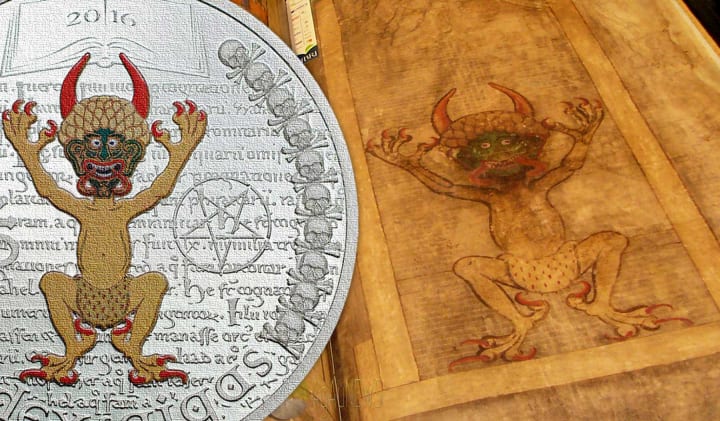10 Mysterious discovery
Surely you will get shock

1., Crucified man:

The crucifixion of Jesus of Nazareth is one of the most well-known and significant events in human history. According to the Christian faith, Jesus was the son of God and came to Earth to save humanity from sin. He was born in Bethlehem around 4 BC and grew up in Nazareth. He began his ministry around the age of 30 and traveled throughout Judea, preaching and performing miracles.
Jesus' teachings and growing following put him at odds with the religious authorities of the time, who felt threatened by his message and popularity. The Roman authorities also viewed Jesus as a potential troublemaker and threat to their rule, and so they arrested him in the Garden of Gethsemane on the night of Maundy Thursday.
Jesus was tried before the Roman governor, Pontius Pilate, who found him guilty of sedition and sentenced him to death by crucifixion. Crucifixion was a common form of punishment in ancient Rome, reserved for those deemed the most dangerous and despised criminals.
The process of crucifixion was brutal and excruciatingly painful. The condemned person was stripped naked and tied or nailed to a wooden cross. The weight of their body would cause their arms to dislocate and their ribcage to expand, making it difficult to breathe. The condemned person would slowly suffocate unless they were able to push themselves up using their legs, which would cause more pain.
Jesus was crucified alongside two other criminals, and he died after several hours on the cross. According to the Bible, he cried out, "My God, my God, why have you forsaken me?" before taking his last breath.
After his death, Jesus' body was taken down from the cross and buried in a nearby tomb. However, on the third day after his crucifixion, his followers reported that the tomb was empty and that they had seen Jesus alive again. This event, known as the resurrection, is the cornerstone of Christian belief and has been celebrated for over 2,000 years.
The story of the crucified man has inspired countless works of art, literature, and music, and has been the subject of intense theological debate and study. The image of the crucified man, with his outstretched arms and wounded side, has become one of the most iconic symbols of Christianity, representing both the sacrifice and the triumph of Jesus over sin and death.
2., ice age structure made of mammoth bones:

One of the most fascinating archaeological discoveries in recent history is the Ice Age structure made of mammoth bones. This structure, also known as a "mammoth house," was found in the Czech Republic in 2015 and is believed to be around 25,000 years old.
The structure was made from the bones of woolly mammoths, which were abundant in the area during the Ice Age. The bones were carefully arranged to form a circular enclosure that measured around 10 meters in diameter. The walls of the enclosure were up to 1.5 meters high and were made from hundreds of mammoth bones that had been stacked on top of each other.
The mammoth house was discovered by a team of archaeologists led by Jiří Svoboda from the University of Hradec Králové. The team had been excavating the area for several years and had uncovered numerous mammoth bones, but the discovery of the mammoth house was a major breakthrough.
The purpose of the mammoth house is not entirely clear, but it is believed to have been used as a shelter by early humans who lived in the area during the Ice Age. The enclosure would have provided protection from the harsh climate and from predators such as wolves and bears.
The discovery of the mammoth house has provided new insights into the lives of early humans during the Ice Age. It is believed that they hunted mammoths for their meat and used their bones for a variety of purposes, including building structures and making tools.
The mammoth house is not the only example of structures made from mammoth bones. Similar structures have been found in other parts of Europe, including Russia and Ukraine. However, the mammoth house in the Czech Republic is one of the most well-preserved and impressive examples of this type of structure.
The discovery of the mammoth house has also sparked renewed interest in the study of the Ice Age and the lives of early humans. Archaeologists are continuing to excavate the area in the hope of uncovering more clues about this fascinating period in human history.
3., 10 million years old teeth:

The discovery of 10 million-year-old teeth provides valuable insight into the evolution of early primates. The teeth were found in East Africa by a team of researchers from the University of Missouri and the National Museums of Kenya.
The teeth belonged to a previously unknown species of primate, which has been named Nyanzapithecus alesi. The species was small, weighing only around 10 kilograms, and is believed to have lived in forests around the time of the Miocene epoch, which lasted from around 23 to 5.3 million years ago.
The discovery of the teeth was made in 2014 when the researchers were excavating a site in the Napudet area of northern Kenya. The site is known for its rich deposits of fossils, but the discovery of the Nyanzapithecus alesi teeth was unexpected and significant.
The teeth are remarkably well-preserved and provide important information about the diet and lifestyle of early primates. The researchers believe that Nyanzapithecus alesi was omnivorous, eating both fruits and insects. The shape and size of the teeth also suggest that the species had a unique way of chewing its food, which may have allowed it to extract more nutrients from its meals.
The discovery of the Nyanzapithecus alesi teeth has also shed new light on the evolution of primates. The species is believed to be an ancestor of modern apes and humans, and its discovery provides valuable clues about the origins of these groups.
The teeth are also significant because they were found in such an old geological deposit. Fossils from this time period are relatively rare, and the discovery of well-preserved teeth from such an early time period is a major breakthrough for researchers studying the evolution of early primates.
The discovery of the Nyanzapithecus alesi teeth has sparked renewed interest in the study of early primate evolution. Researchers are continuing to excavate the Napudet site and other areas in East Africa in the hope of uncovering more fossils that will shed new light on this fascinating period in human history.
4., Ancient lovers locked in an embrace:

The story of the ancient lovers locked in an embrace is a fascinating tale that has captured the hearts and imaginations of people around the world. The lovers are believed to have lived in the city of Mantua in northern Italy during the Roman Empire, around the 1st or 2nd century AD.
The lovers were discovered in 1972 by a team of archaeologists who were excavating a burial site in Mantua. The site was part of a necropolis, or cemetery, that was used by the ancient Romans.
The lovers were found in a tomb that had been sealed with a large stone slab. Inside the tomb, the archaeologists discovered the remains of two individuals, a man and a woman, who were believed to have died around the same time.
What made the discovery so remarkable was that the bodies were found locked in an embrace, with the man's arms wrapped around the woman's waist and their faces pressed together. The position suggested that the couple had died in each other's arms, possibly as a result of a tragic event such as a disease or a natural disaster.
The discovery of the lovers has captured the imaginations of people around the world, and many have speculated about their story. Some have suggested that the couple were star-crossed lovers who had been forced to keep their relationship a secret, while others have speculated that they were victims of a tragic accident.
Despite the many theories, the true story of the ancient lovers remains a mystery. However, their discovery has provided valuable insights into the lives and customs of the ancient Romans.
The lovers were buried according to the Roman custom of burying couples together. This practice was reserved for couples who were married or who had a close relationship, such as siblings or parent and child. The custom suggests that the couple were deeply in love and were likely married.
The discovery of the lovers has also shed new light on the role of women in ancient Rome. The woman's position in the tomb, with her head resting on the man's shoulder, suggests that she held an important place in his life. This suggests that women in ancient Rome had more freedom and autonomy than previously believed.
Today, the lovers remain one of the most iconic and enduring symbols of love and devotion. Their story has inspired countless artists, writers, and poets, and their embrace continues to capture the hearts and imaginations of people around the world.
5., Codes gigas:

The Codex Gigas, also known as the Devil's Bible, is a medieval manuscript that is famous for its size, complexity, and mysterious origins. The book is over 800 years old and is considered one of the most remarkable and unusual manuscripts in history.
The Codex Gigas was created in the 13th century by an unknown monk who lived in the Benedictine monastery of Podlažice, in what is now the Czech Republic. The manuscript is so large that it requires two people to carry it, and it contains over 600 pages of handwritten text.
What makes the Codex Gigas so remarkable is that it contains a wide range of texts, including the entire Latin Bible, historical chronicles, medical and scientific treatises, and even an encyclopedia of magical spells and incantations. The book is also decorated with elaborate illustrations, including images of heaven and hell, demons, and the devil himself.
The most famous section of the Codex Gigas is the portrait of the devil, which occupies an entire page of the book. The image is highly detailed and shows the devil sitting on a throne, with a serpent wrapped around his leg and a pair of horns protruding from his head. The devil's eyes are piercing and seem to stare directly at the viewer, creating an unsettling and eerie effect.
The Codex Gigas is shrouded in mystery and legend, and many stories have emerged about its creation and contents. According to one legend, the monk who created the book was sentenced to be walled up alive for breaking his monastic vows. In an attempt to avoid this fate, he promised to create a book that would glorify the monastery and demonstrate his piety. He was given a deadline of one year to complete the book, but he knew that he would never be able to finish it in time. In desperation, he made a pact with the devil, offering his soul in exchange for the completion of the book. The devil agreed, and the monk was able to complete the Codex Gigas in just one night.
While this story is almost certainly apocryphal, the Codex Gigas remains a fascinating and enigmatic manuscript that continues to captivate scholars and enthusiasts alike. The book is now housed in the National Library of Sweden in Stockholm, where it is carefully preserved and studied. Despite centuries of study, however, many of the secrets and mysteries of the Codex Gigas remain unsolved, ensuring that the book will continue to fascinate and intrigue generations to come.
6., Mapimi silent zone:

The Mapimí Silent Zone is a region of northern Mexico that has become famous for its mysterious and unexplained phenomena. The area is located in the state of Durango, near the city of Mapimí, and covers an area of approximately 30,000 square kilometers.
The Mapimí Silent Zone gained notoriety in the 1970s when an American missile, the Athena missile, fell off course and crashed into the region. The missile was carrying a nuclear warhead, but fortunately, the warhead did not detonate, and there were no casualties. However, the incident sparked a wave of interest in the area, and many people began to speculate that the region was cursed or haunted.
One of the most famous mysteries of the Mapimí Silent Zone is the phenomenon of radio silence. According to reports, radio transmissions are almost impossible in the area, and many people have reported strange static or interference on their radios and other electronic devices. Some have even claimed that the radio silence is so strong that it can cause vehicles to stop working or disrupt airplane navigation systems.
Another mystery of the Mapimí Silent Zone is the presence of strange and unusual animals. Many people have reported seeing strange creatures in the area, including giant bats, bizarre reptiles, and even extraterrestrial beings. While these reports are often dismissed as hoaxes or exaggerations, some researchers believe that the unique geological features of the region may have created an environment that is conducive to the evolution of unusual and exotic creatures.
The origins of the Mapimí Silent Zone's mysterious phenomena remain unclear, and many theories have been proposed to explain the strange events that occur in the region. Some have suggested that the area is home to powerful magnetic fields or gravitational anomalies that disrupt radio signals and electronic devices. Others have speculated that the region is the site of secret military experiments or that it is connected to ancient alien civilizations.
Despite decades of investigation, the Mapimí Silent Zone remains a fascinating and enigmatic place, full of mystery and intrigue. While many of the claims and legends surrounding the region may be exaggerated or untrue, the area continues to captivate the imaginations of people around the world and remains a popular destination for adventurous travelers and curious researchers alike.
7., Flannan Isle lighthouse:

Flannan Isle Lighthouse, located on a remote island off the west coast of Scotland, has a history that is both tragic and mysterious. Built in 1899 to guide ships safely through the treacherous waters of the North Atlantic, the lighthouse became the site of one of the most enduring mysteries in maritime history.
The three lighthouse keepers assigned to Flannan Isle were James Ducat, Thomas Marshall, and Donald McArthur. On December 15, 1900, a relief boat arrived at the island to deliver supplies and bring a new crew of keepers to relieve the old crew. However, when the relief crew arrived, they found no sign of the three men who were supposed to be manning the lighthouse.
Upon further investigation, it became clear that something was amiss. The lighthouse had been left in perfect working order, with no signs of a struggle or any indication of what might have happened to the missing keepers. The only clue was a strange entry in the lighthouse logbook, which read:
"December 12th. Gale north by northwest. Sea lashed to fury. Stormbound 9pm. Never seen such a storm. Everything shipshape. James Ducat irritable."
Despite extensive searches of the island and the surrounding waters, no trace of the missing men was ever found. Some theories have suggested that they were swept out to sea by the storm, while others have proposed that they were taken by supernatural forces or even abducted by extraterrestrial beings.
Over the years, many people have tried to solve the mystery of what happened on Flannan Isle. In 1912, the songwriter Wilfrid Wilson Gibson wrote a poem entitled "Flannan Isle" that captured the haunting atmosphere of the lighthouse and the mystery surrounding its vanished keepers. In 2018, a new theory emerged that suggested the men had been killed by a rogue wave that washed over the island.
Despite these efforts, the true fate of the three lighthouse keepers remains unknown. The mystery of Flannan Isle continues to captivate and intrigue people around the world, and the remote lighthouse remains a haunting reminder of the dangers that lurk in the sea.
8., witch bottle:

A witch bottle is a type of magical object that has been used for centuries in various cultures as a form of protection against evil spirits, witches, and other supernatural entities. The history and mystery surrounding witch bottles is a fascinating topic that spans centuries and cultures.
The origins of witch bottles can be traced back to Europe in the 16th and 17th centuries, when they were used as a form of protection against witchcraft. These bottles were typically made from glass, pottery, or other materials and contained a variety of items, including nails, hair, urine, and other personal items.
The idea behind the witch bottle was that the items contained within it would serve as a sort of decoy for any evil spirits or witches who might be trying to harm the person who had created the bottle. The bottle would be buried, often near the home of the person who had created it, and the presence of the items inside was believed to confuse and distract any evil spirits or witches who might be trying to do harm.
In addition to their use as a form of protection against witchcraft, witch bottles were also sometimes used as a means of revenge or to cause harm to others. In these cases, the bottle would be filled with items that were believed to have the power to cause harm, such as pins, nails, and thorns.
Despite their popularity in the past, the use of witch bottles has largely fallen out of favor in modern times. However, they continue to hold a fascination for many people, and there are still those who believe in their power to protect against evil spirits and witches.
One of the most famous examples of a witch bottle is the one that was discovered in 2004 in Greenwich, England. The bottle, which was believed to date back to the late 17th century, contained human urine, nail clippings, hair, and pins, and was found buried under the floorboards of a house. The discovery of this bottle sparked renewed interest in the use of witch bottles and their place in history and folklore.
In conclusion, witch bottles are a fascinating artifact that has been used for centuries to protect against evil spirits and witches. While their use has largely fallen out of favor in modern times, they continue to be a subject of interest and fascination for many people. Whether one believes in their power or not, the history and mystery surrounding witch bottles is a fascinating topic that offers a glimpse into the beliefs and fears of people from centuries past.
9., Hoer verde mystery:

The Hoer Verde Mystery is a story of a group of German settlers who disappeared without a trace in the jungles of Brazil in the early 20th century. The mystery surrounding their disappearance has captivated the imaginations of people around the world and remains unsolved to this day.
The story begins in 1923 when a group of around 100 German immigrants arrived in the Brazilian state of Acre, with the intention of settling in the region and establishing a new colony. The group included men, women, and children, and they brought with them all the supplies they would need to start their new life in the jungle.
The settlers established their new community, which they called Hoer Verde, and began to build homes and cultivate the land. However, after only a few months, the entire community vanished without a trace.
Despite extensive searches of the surrounding jungle and investigations by Brazilian authorities, no trace of the settlers was ever found. The only clues were a few abandoned buildings and fields that showed signs of recent cultivation.
The disappearance of the Hoer Verde settlers has led to numerous theories and speculations about what might have happened to them. Some believe that they were attacked and killed by indigenous tribes in the region, while others believe that they were the victims of disease or other natural disasters.
Another theory is that the settlers may have been the victims of foul play at the hands of rival settlers or other groups with a stake in the region. There are also those who believe that the settlers may have simply become disillusioned with their new life in the jungle and decided to return to Germany or move to another part of Brazil.
Despite the many theories and speculations, the true fate of the Hoer Verde settlers remains a mystery to this day. The story of their disappearance has captured the imaginations of people around the world, and the jungle that swallowed them up continues to be a place of fascination and intrigue.
In conclusion, the Hoer Verde Mystery is a story of a group of German settlers who disappeared without a trace in the Brazilian jungle in the early 20th century. The mystery surrounding their disappearance has given rise to numerous theories and speculations, but the true fate of the settlers remains unknown. The story of the Hoer Verde settlers serves as a reminder of the dangers and uncertainties that await those who venture into the unknown.
10., ice man:

The Ice Man, also known as Ötzi, is the name given to a well-preserved mummy of a man who lived over 5,000 years ago. The mummy was discovered in 1991 in the Ötztal Alps on the border between Austria and Italy and has become one of the most significant archaeological finds of the 20th century.
The discovery of the Ice Man mummy has shed light on the life and culture of people who lived in the region during the Copper Age. The mummy is exceptionally well-preserved, with skin, hair, and clothing still intact, and has provided valuable insights into the diet, clothing, and tools of the people who lived in the region over 5,000 years ago.
Despite the valuable insights provided by the Ice Man mummy, there are still many mysteries surrounding his life and death. One of the most significant mysteries is how he died. Analysis of the mummy has revealed that he suffered a fatal arrow wound, but the circumstances surrounding his death remain unclear. Some theories suggest that he may have been a victim of a tribal conflict, while others believe that he may have been killed in a personal dispute or robbery.
Another mystery surrounding the Ice Man is how he came to be so well-preserved. The mummy was found in a glacier and was likely preserved by the cold temperatures and lack of oxygen in the ice. However, the exact circumstances of his preservation are still not fully understood.
The discovery of the Ice Man mummy has captured the imagination of people around the world and has led to numerous studies and investigations into his life and culture. In addition to providing valuable insights into the Copper Age, the Ice Man has also become a symbol of human resilience and the enduring mysteries of our past.
In conclusion, the Ice Man is a well-preserved mummy of a man who lived over 5,000 years ago and was discovered in the Ötztal Alps in 1991. While the discovery of the mummy has provided valuable insights into the life and culture of people who lived in the region during the Copper Age, many mysteries surrounding his life and death remain unsolved. The Ice Man has become a symbol of human resilience and the enduring mysteries of our past.
About the Creator
Enjoyed the story? Support the Creator.
Subscribe for free to receive all their stories in your feed. You could also pledge your support or give them a one-off tip, letting them know you appreciate their work.






Comments
There are no comments for this story
Be the first to respond and start the conversation.